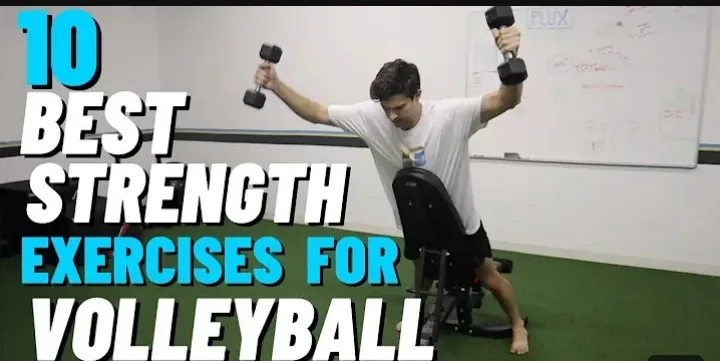As a beginner in volleyball, it’s important to focus on building your overall athleticism, strength, weight, and composure to improve your performance on the court.
As such, volleyball strength exercises are the best volleyball workouts to start with as a beginner. Remember, the volleyball game is a game of strength, power, agility, and endurance.
To train yourself to be a good volleyball player, you must focus on building your core strength, upper body strength, lower body strength, power and explosiveness, flexibility and mobility, cardiovascular endurance, hitting power, and so on.
After that, you have to focus on volleyball-specific skills training like footwork, jumping and landing, serving, passing, setting, hitting, blocking, defense, and overall volleyball game sense.
Can you self-teach volleyball?
Yes!
With the help of this article and other resources like YouTube and social media platforms, you can self-teach volleyball.
But self-teaching has limitations, and you may lack coaching experience. Training with a coach or experienced player can provide more in-depth volleyball skills and habits that will help you in more professional competition.
Basic Volleyball Skills for Beginners
Mastering the basic volleyball skills is important for every volleyball beginner. This will help you build a strong foundation in volleyball for professional performances.
Although there are many volleyball skills, a beginner may have to start with the basics. So we are going to focus on just seven basic volleyball skills for beginners.
What are the seven basic skills in volleyball for beginners?
Below are the 7 basic volleyball skills for beginners to start with:
- Serving: the ability to hit the ball over the net and into the opponent’s court.
- Passing: The ability to receive the serve and set the ball for the team.
- Setting: The ability to set the ball for the attackers to hit.
- Hitting: the ability to attack the ball and score points.
- Blocking: The ability to stop the opponent’s attack at the net.
- Diggering: The ability to defend against the opponent’s attack and prevent the ball from touching the ground.
- Spiking: The ability to hit the ball sharply into the opponent’s court, usually from an attack position.
Read More: Basic Skills in Volleyball
10 Best Volleyball Strength Exercises for Beginners
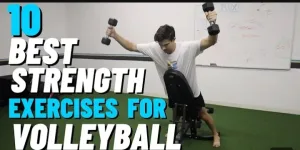
As a beginner, all your training should be focused on developing the required volleyball strength and skills. So you can follow the steps below to practice volleyball skills at home as a beginner:
1. Squats
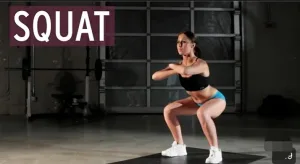
Squats are one of the fundamental volleyball strength exercises for building lower body strength, which is important for jumping and explosive movements in volleyball.
How to do it:
Step 1: Stand with your feet shoulder-width apart.
Step 2: Lower your body by bending your knees and hips, keeping your back straight.
Step 3: Go down until your thighs are parallel to the ground.
Step 4: Push through your heels to return to the starting position.
2. Push-Ups
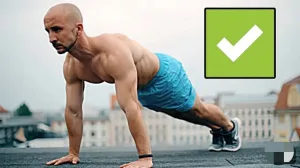
Push-ups are the 2nd volleyball strength exercise on our list. They help build upper-body strength, particularly in the chest, shoulders, and triceps. Building strength around these regions is essential for powerful volleyball serves and spikes.
How to do it:
Step 1: Start in a plank position with hands shoulder-width apart.
Step 2: Lower your body until your chest nearly touches the ground.
Step 3: Push back up to the starting position, keeping your body straight throughout.
3. Deadlifts
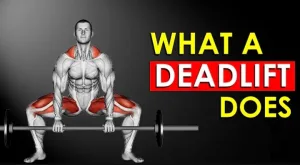
According to Wikipedia, a deadlift is a weight- and strength-training exercise in which a loaded barbell or bar is lifted off the ground to the level of the hips, torso perpendicular to the floor, before being placed back on the ground.
Deadlift helps in building the posterior chain, which includes the back, glutes, and hamstrings. It builds the muscles of the back, shoulders, and legs to improve posture while also helping to build strength and muscle mass.
Deadlifts are a very basic and important volleyball strength exercise for powerful movements like spiking and blocking.
How to do it:
Step 1: Stand with feet hip-width apart, barbell in front of you.
Step 2: Bend at the hips and knees to grasp the barbell with an overhand grip.
Step 3: Lift the bar by straightening your hips and knees, keeping your back straight.
Step 4: Lower the bar back to the ground with controlled movement.
4. Box Jumps
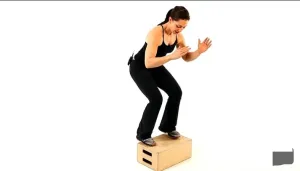
Box jumps are one of the basic volleyball exercises for beginners that enhance explosive power and improve vertical jump height, which are needed for both offense and defense in volleyball.
How to do it:
Step 1: Stand in front of a sturdy box or platform.
Step 2: Bend your knees slightly and swing your arms for momentum.
Step 3: Jump onto the box, landing softly on the balls of your feet.
Step 4: Step or jump back down and repeat.
5. Agility Ladder Drills
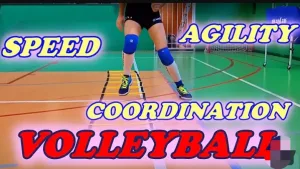
Agility ladder drills are basic volleyball drills that can improve foot speed, coordination, and agility for quick movements on the volleyball court.
How to do it:
Step 1: Lay an agility ladder on the ground.
Step 2: Perform various footwork patterns, such as high knees, side shuffles, and in-and-out steps, through the ladder.
6. Planks
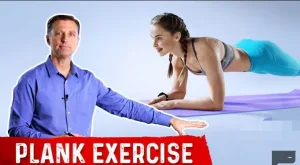
Plank is an isometric core strength exercise that involves maintaining a position similar to a push-up without making any movement. The exercise is a total-body engagement exercise.
This exercise is good for working the legs, core, back, arms, and shoulders. It is an important exercise for stability and balance during volleyball movements.
How to do it:
Step 1: Start in a forearm plank position, elbows directly under your shoulders.
Step 2: Keep your body in a straight line from head to heels.
Step 3: Hold the position for as long as possible while focusing on engaging your core.
7. Cable Rotations
Cable rotation exercises help strengthen the core and improve rotational power. This is a good exercise for hitting and serving.
How to do it:
Step 1: Stand next to a cable machine with the handle set at waist height.
Step 2: Hold the handle with both hands and step away to create tension.
Step 3: Rotate your torso away from the machine, pulling the handle across your body.
Step 4: Control the return to the starting position and repeat.
8. Lateral Lunges
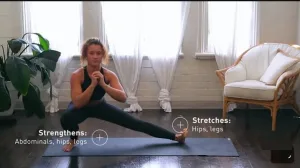
This is a basic bodyweight exercise that works multiple muscle groups throughout your lower body. Lateral lunges enhance lateral movement and agility.
In volleyball, lateral movement and agility are important for quick directional changes on the volleyball court.
How to do it:
Step 1: Stand with your feet hip-width apart.
Step 2: Step to the side with one foot, bending that knee while keeping the other leg straight.
Step 3: Push back to the starting position and repeat on the other side.
9. Burpees
Burpees are a full-body exercise that improves cardiovascular fitness, strength, and explosiveness.
How to do it:
Step 1: Start in a standing position.
Step 2: Drop into a squat and place your hands on the ground.
Step 3: Jump your feet back into a plank position.
Step 4: Perform a push-up, then jump your feet back to your hands.
Step 5: Explode into a jump, reaching your arms overhead.
10. Medicine Ball Slams
The medicine ball slam is a simple volleyball workout exercise that involves lifting the ball over your head and slamming it to the ground in front of your feet.
This is not just a simple exercise but a total body movement exercise that is good for building upper body power and core strength, which are useful for powerful attacks and serves in volleyball.
How to do it:
Step 1: Stand with your feet shoulder-width apart, holding a medicine ball.
Step 2: Lift the ball overhead with both hands.
Step 3: Slam the ball to the ground as hard as you can, engaging your core.
Step 4: Catch the ball on the rebound and repeat.
How can a beginner get better at volleyball?
The only and easiest way to get better at volleyball as a beginner is to train regularly, engage in strength exercises, and do skill workouts.
These volleyball exercises and workouts will help prepare you energetically for volleyball competitions.
While training, you can consider employing the services of a volleyball coach or an experienced volleyball player to assist you in training for a better result.
See Also:
- Volleyball Drills for Freshman: A Comprehensive Guide
- Volleyball Bumping Drills for Beginners
- Discover Home Volleyball Training Equipment
- Volleyball Tryout Drills
Easy Volleyball Workout Plan for Beginners
If you’re new to volleyball, you can start with the basic exercises that were explained earlier. To assist you better, you can use this beginner-friendly workout plan during your workout:
- Exercise 1: Before you start your workout exercises, make sure you warm up for about 5–10 minutes. You can do light jogging or jump rope as your warm-up exercise.
- Exercise 2: After the warm-up, engage in thorough bodyweight exercises like push-ups, squats, and planks.
- Exercise 3: After exercise 2, move to basic plyometric workouts like jumping jacks and lateral jumps.
- Exercise 4: After exercise 3, take a cool-down break with static stretching.
- Repeat exercises 1–3 again until you feel satisfied, and feel free to repeat this for other days.
Conclusion
As a beginner, you must train yourself to a professional level to be relevant in the world of volleyball. You can achieve this gradually by engaging in skillful volleyball workouts.
These volleyball strength exercises for beginners can be a good guide to start with. Nevertheless, also remember that self-training is not enough.
As you grow, consider employing the services of a volleyball coach or experienced volleyball player to assist you in training for a better result.
Related: Volleyball Workouts at Home and the Gym (7-day plan)

